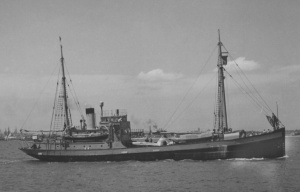HMAS Wyatt Earp was originally built for the Norwegian fishing trade. It was a single deck motor vessel built of pine and oak.
Service as a herring boat ended when it was purchased by the American explorer Lincoln Ellsworth for his 1933 Antarctic expedition. Ellsworth refitted and sheathed Fanefjord with oak and armour plate and renamed its Wyatt Earp in memory of the legendary US marshal of Dodge City and Tombstone.
Wyatt Earp was used by Ellsworth on 4 Antarctic expeditions from 1933 to 1939 as a base ship for his aircraft.
In February 1939 it was purchased from Ellsworth by the Commonwealth Government and handed over to the Royal Australian Navy (RAN). The RAN intend to use Wyatt Earp as a fleet auxiliary (ammunition and store carrier).
On 8 September 1939 it was decided to rename it Boomerang. This name, however, was rejected when it was found that a vessel of that name was already registered in Australia. On 25 October 1939 it was named Wongala, an indigenous word meaning boomerang.
Wongala began service as a Royal Australian Fleet Auxiliary on 14 November 1939 when it departed Sydney for Darwin with a cargo of stores. This was Wongala’s only voyage as a fleet auxiliary. On return to Sydney on 11 January 1940 it was laid up pending a decision on its future employment.
The Kingfisher seaplane conducted test flights on 13 March but proved to be too cumbersome for frequent use in a ship of Wyatt Earp’s size. Additionally, the preheater for the engine needed to be run for 24 hours before flight. Heavy, dense pack ice frustrated attempts to reach Adelie Land so that on 14 March after trying to penetrate the ice, the ship turned back to avoid becoming trapped and course was finally set northward for Macquarie Island. In the previous 3 weeks, several islands had been surveyed, and errors in their charted positions corrected, and several scientific experiments conducted.
Wyatt Earp came to anchor at Buckles Bay, Macquarie Island on 20 March, and found that LST 3501 (later named HMAS Labuan), which had sailed from Melbourne on 28 February 1948 with a party of scientists on board, was already at anchor and had a landing party ashore setting up a Station.
The 2 ships stayed together until 24 March by which time the scientific party was well established ashore for a stay of one year. Wyatt Earp departed from Macquarie Island for Melbourne on 24 March and LST 3501 left for Melbourne, via Hobart, the following day.
Specifications
 |
| Type |
Antarctic Exploration Vessel |
|---|---|
| Builder |
Bolsönes Shipyard, Molde, Norway |
| Commissioned |
17 November 1947 |
| Decommissioned |
January 1959 |
| Fate |
Ran aground on 23/24 January 1959 |
| Dimensions & Displacement | |
| Displacement | 402 tons |
| Length | 135 feet 7 inches |
| Beam | 29 feet 2 inches |
| Draught | 14 feet 4 inches |
| Performance | |
| Speed | 8.5 knots |
| Propulsion | |
| Machinery | Semi-diesel engines, single screw |
| Horsepower | 400 |
| Armament | |
| Guns | Machine guns |
| Other Armament | 1 x Oerlikon |



